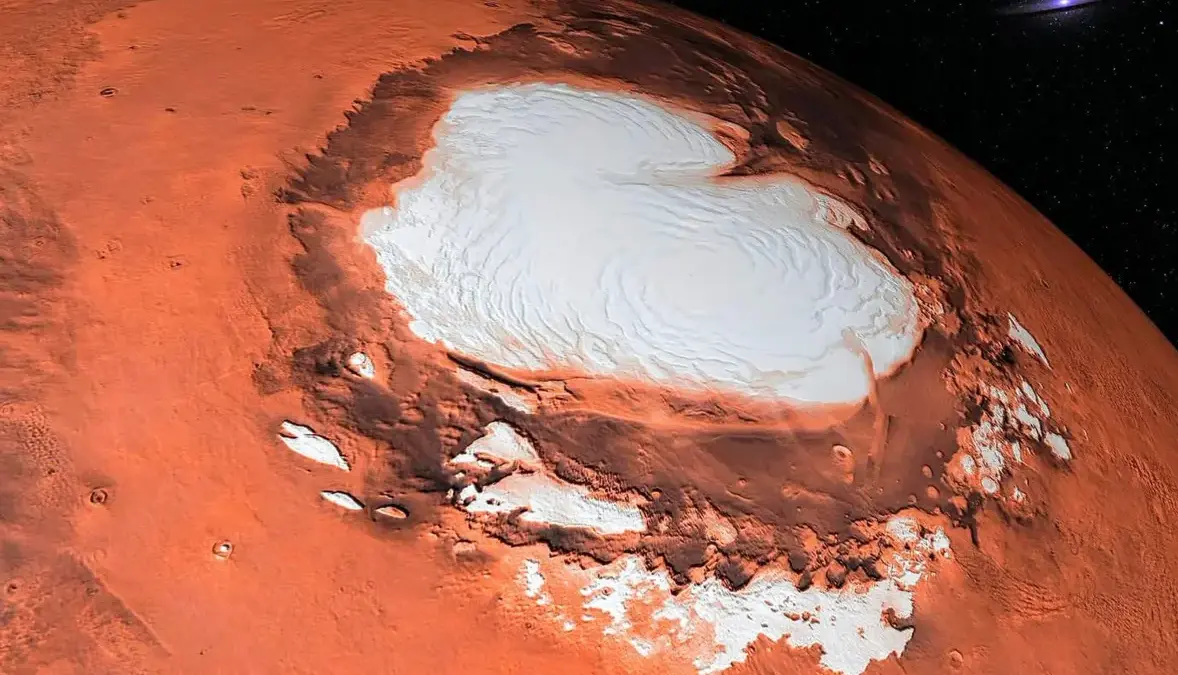Scientists have long been interested in the question: is there life on Mars? While there is no concrete evidence yet, a recent NASA study has sparked new curiosity. Research suggests that frozen water beneath the surface of Mars could potentially harbor microbial life. Photosynthetic potential on Mars
Based on computer simulations, scientists discovered that sunlight can penetrate water ice, enabling photosynthesis in meltwater pools beneath the surface.
Photosynthesis is the process used by plants and other organisms to convert light energy into chemical energy for food. Ice formations filled with algae, fungi and cyanobacteria, all of which thrive on photosynthesis, have been discovered on Earth. Could Mars host such life forms?
The research was led by Aditi Huller, who works at NASA’s Jet Propulsion Laboratory (JPL) in Southern California.
“If we were trying to find life anywhere in the universe today, Martian ice is probably one of the most accessible places we should look,” Huller said.
Life in the frozen water of Mars
Because Mars has two types of ice (frozen water and frozen carbon dioxide), scientists have focused on water ice as a potential source of life. Experts have traced the origin of this ice to ancient snow mixed with dust during Mars’ ice ages over the last million years. This snow mixture, which has now solidified into ice, continues to carry dust.
While dust has the potential to block light in deeper layers of ice, it holds the key to how underground reservoirs can form in ice under the influence of the Sun. Just as a black shirt absorbs more sunlight than a white shirt, dark dust absorbs more sunlight than the surrounding ice. This could potentially heat and melt surrounding ice, even several meters below the surface.
But not all scientists who study Mars agree on whether ice can actually melt under the influence of the Martian surface. The problems arise from Mars’ thin, dry atmosphere, where water ice tends to sublimate; This means that it turns directly into a gas similar to our dry ice on Earth. But these atmospheric limitations do not interfere with powdery snow or glacier subsurface.
Phenomena similar to cryoconite holes (small cavities formed in the ice by windblown dust particles) on Earth can also be observed on Mars. These dust particles, which absorb sunlight and turn to ice, could potentially create pockets of meltwater, paving the way for thriving ecosystems for simple life forms.
“This is a common occurrence on Earth,” said study co-author Phil Christensen of Arizona State University, referring to ice melting from the inside. “Instead of melting from top to bottom, heavy snow and ice can melt from the inside to the outside, allowing sunlight to warm them up, like a greenhouse.”
Could the Martian climate support life?
Understanding Mars’ climate is critical to assessing its ability to support life. Temperatures on Mars are much colder than on Earth, with the average surface temperature around -80 degrees Fahrenheit (-62 degrees Celsius).
Such frigid conditions are caused by its thin atmosphere composed mostly of carbon dioxide, which provides minimal insulation against extreme cold.
However, changes in Mars’ axial tilt and orbit can lead to climate changes similar to seasons on Earth, but with more extreme variations. This dynamic behavior of the atmosphere raises curiosity about how these changes might affect ice stability and potential habitats.
Future exploration of Mars
The quest to unravel the mysteries of Mars remains at the forefront of planetary exploration. Future missions, such as NASA’s Mars Sample Return mission, aim to collect Martian rocks and soil for unprecedented analysis.
These samples can provide invaluable information about Martian geology, climate history, and potential biosignatures that are indicators of past or present life. In addition, advanced technologies such as spacecraft and robotic systems allow more precise and comprehensive examination of the Martian surface.
Main targets for future research
Christensen and Huller’s latest paper theorizes that powder ice can transmit enough light for photosynthesis even three meters below the surface. This could protect underground pools of water from evaporation and protect against harmful radiation, given that Mars does not have a protective magnetic field like Earth.
Interestingly, water ice, most likely forming subsurface basins, would be present in the tropical regions of Mars between 30 and 60 degrees latitude, in both the northern and southern hemispheres.
Continuing this exciting research, Huller plans to reproduce some of the dust ice on Mars in the laboratory. Meanwhile, scientists around the world are mapping promising places on Mars to look for shallow meltwater. These places could become prime targets for future scientific efforts involving both human and robotic researchers.













